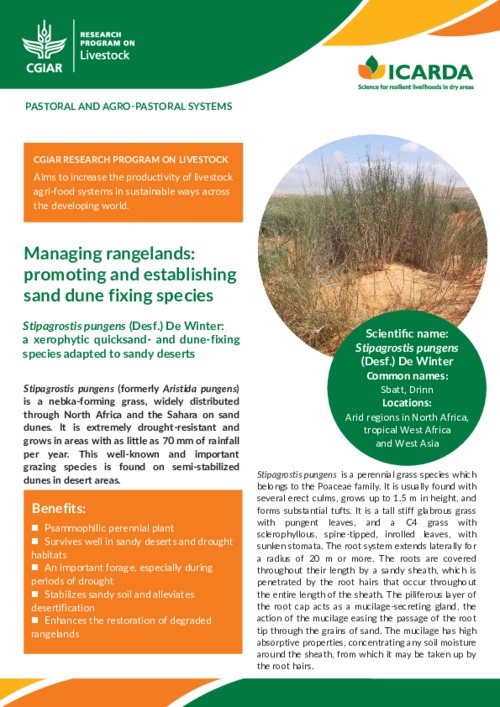Quelques idées sur l’utilisation d’indicateurs fonciers dans le pastoralisme au Sénégal
Management matters: Testing a mitigation strategy for nitrous oxide emissions using legumes on intensively managed grassland
Guide for training of pastoralists (women) in Borana Zone, Oromia Region, Ethiopia on good milk production, handling and processing practices and prevention of the transmission of milk-borne zoonotic diseases
Managing rangelands: promoting and establishing sand dune fixing species: Stipagrostis pungens (Desf.) De Winter: a xerophytic quicksand- and dune-fixing species adapted to sandy deserts
Stipagrostis pungens is a perennial grass species which belongs to the Poaceae family. It is usually found with several erect culms, grows up to 1.5 m in height, and forms substantial tufts. It is a tall stiff glabrous grass with pungent leaves, and a C4 grass with sclerophyllous, spine-tipped, inrolled leaves, with sunken stomata. The root system extends laterally for a radius of 20 m or more. The roots are covered throughout their length by a sandy sheath, which is penetrated by the root hairs that occur throughout the entire length of the sheath.
Coupling land-use change and hydrologic models for quantification of catchment ecosystem services
Representation of land-use and hydrologic interactions in respective models has traditionally been problematic. The use of static land-use in most hydrologic models or that of the use of simple hydrologic proxies in land-use change models call for more integrated approaches. The objective of this study is to assess whether dynamic feedback between land-use change and hydrology can (1) improve model performances, and/or (2) produce a more realistic quantification of ecosystem services. To test this, we coupled a land-use change model and a hydrologic mode.
Coupling land-use change and hydrologic models for quantification of catchment ecosystem services
Representation of land-use and hydrologic interactions in respective models has traditionally been problematic. The use of static land-use in most hydrologic models or that of the use of simple hydrologic proxies in land-use change models call for more integrated approaches. The objective of this study is to assess whether dynamic feedback between land-use change and hydrology can (1) improve model performances, and/or (2) produce a more realistic quantification of ecosystem services. To test this, we coupled a land-use change model and a hydrologic mode.


